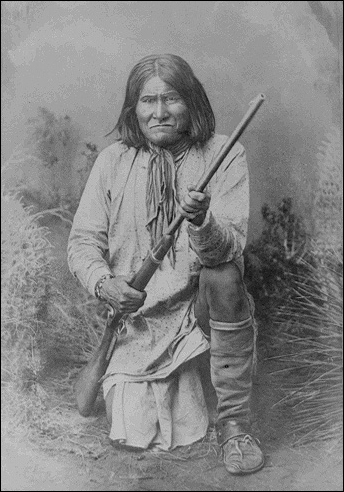

The Chiricahua Mountains are found along the western border of the Chihuahuan Desert in southeastern Arizona. The term Chiricahua refers to one of seven Apache tribes, each having its own dialect. The Indians were named after the mountains, and not the mountains after the Indians. There were three distinct bands of the Chiricahuas, and the Apache had individual names for each of these. However, they had no collective name for them as a single group that would be equivalent to the name, "Chiricahua Apache". Two of the most famous Apaches, Geronimo and Cochise, were members of this tribe.
By 1913, the tribe had been reduced from 500 individuals to 271, of
which about 1/3 was sent to Fort Sill, Oklahoma. The rest were sent to live with the
Mescalero Apache on the reservation in New Mexico, and they now speak the Mescalero
dialect. By 1981, only five Fort Sill Apache spoke the original language, and all were
over 50 years of age. The dialect of the most famous band of Apaches has probably been
lost forever.

Listen to the Audio (mp3 format) as recorded by KTEP, Public Radio for the Southwest.
Contributor: William Mackay, Laboratory for Environmental Biology, University of Texas at El Paso.
Desert Diary is a joint production of the Centennial Museum and KTEP National Public Radio at the University of Texas at El Paso.

Photograph of Geronimo. Wittick Collection, Centennial Museum.
Barrett, S. M. 1996. Geronimo, His Own Story: The Autobiography of a Great Patriot Warrior as told to S. M. Barrett. Penguin Books, New York, 190 pp.
Mails, T. E. 1974. The People Called Apache. Prentice-Hall, Englewood Cliffs, NJ.
Schwarz, M. 1993. North American Indians of Achievement: Cochise: Apache Chief. Chelsa House Publishers, New York, 119 pp. [Recommended for Middle School and above.]
Sonnichsen, C. L., Ed. 1986. Geronimo and the End of the Apache Wars. University of Nebraska Press, Lincoln, 136 pp.
Sweeney, E. R. 1991. Cochise: Chiricahua Apache Chief. University of Oklahoma Press, Norman, 501 pp.